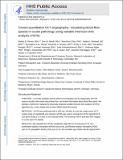TOWARD QUANTITATIVE OPTICAL COHERENCE TOMOGRAPHY ANGIOGRAPHY: Visualizing Blood Flow Speeds in Ocular Pathology Using Variable Interscan Time Analysis
Author(s)
Ploner, Stefan B; Moult, Eric Michael; Choi, WooJhon; Lee, ByungKun; Potsaid, Benjamin M.; Schottenhamml, Julia Jennifer; Fujimoto, James G; ... Show more Show less
DownloadAccepted version (3.548Mb)
Open Access Policy
Open Access Policy
Creative Commons Attribution-Noncommercial-Share Alike
Alternative title
Toward quantitative OCT angiography: visualizing blood flow speeds in ocular pathology using variable interscan time analysis (VISTA)
Terms of use
Metadata
Show full item recordAbstract
Purpose: Currently available optical coherence tomography angiography systems provide information about blood flux but only limited information about blood flow speed. The authors develop a method for mapping the previously proposed variable interscan time analysis (VISTA) algorithm into a color display that encodes relative blood flow speed. Methods: Optical coherence tomography angiography was performed with a 1,050 nm, 400 kHz A-scan rate, swept source optical coherence tomography system using a 5 repeated B-scan protocol. Variable interscan time analysis was used to compute the optical coherence tomography angiography signal from B-scan pairs having 1.5 millisecond and 3.0 milliseconds interscan times. The resulting VISTA data were then mapped to a color space for display. Results: The authors evaluated the VISTA visualization algorithm in normal eyes (n = 2), nonproliferative diabetic retinopathy eyes (n = 6), proliferative diabetic retinopathy eyes (n = 3), geographic atrophy eyes (n = 4), and exudative age-related macular degeneration eyes (n = 2). All eyes showed blood flow speed variations, and all eyes with pathology showed abnormal blood flow speeds compared with controls. Conclusion: The authors developed a novel method for mapping VISTA into a color display, allowing visualization of relative blood flow speeds. The method was found useful, in a small case series, for visualizing blood flow speeds in a variety of ocular diseases and serves as a step toward quantitative optical coherence tomography angiography.
Date issued
2016-12Department
Massachusetts Institute of Technology. Research Laboratory of Electronics; Massachusetts Institute of Technology. Institute for Medical Engineering & Science; Massachusetts Institute of Technology. Department of Electrical Engineering and Computer ScienceJournal
Retina
Publisher
Ovid Technologies (Wolters Kluwer Health)
Citation
Ploner, Stefan B. et al. “Toward quantitative OCT angiography: visualizing blood flow speeds in ocular pathology using variable interscan time analysis (VISTA).” Retina, 36 (Suppl 1), 12 (December 2016): S118–S126 © 2016 The Author(s)
Version: Author's final manuscript
ISSN
0275-004X